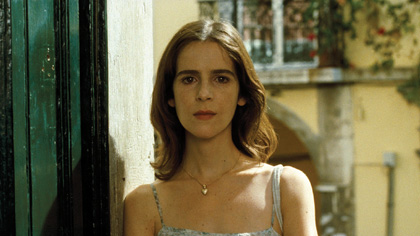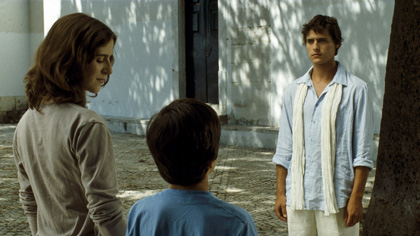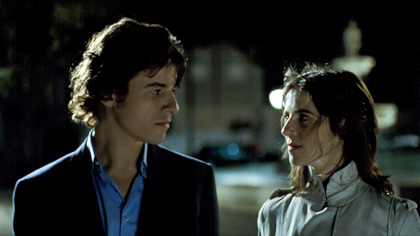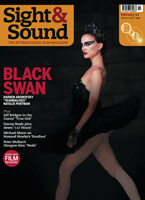Film of the month: The Portuguese Nun

The Bressonian style and metaphysical concerns of Eugène Green may be an acquired taste, but they achieve their most perfect expression in his new film The Portuguese Nun. Peter Matthews finds himself ripe for conversion
Checking in at a Lisbon hotel, actress Julie de Hauranne tells the receptionist about her current project, a minimalist exercise composed of silent visuals and a 17th-century French text to be read entirely off screen. Unimpressed, the receptionist replies: “I never see French films. They’re for intellectuals.” Speaking later to a make-up girl, Julie euphemistically describes the approach as “unconventional”. “Boring, you mean,” is the tart rejoinder. Julie’s quiet demurral – “I hope not. The story moves me” – perhaps supplies the key to writer-director Eugène Green’s ravishing new work.
Far from wishing to pull rank on the philistine tastes of dressers and concierges, Green wryly and stoically acknowledges that his recherché style won’t grab everyone. With its zombified performances, oracular dialogue and tone of deliberate mystification, The Portuguese Nun is apt to strike the uninitiated as howlingly pretentious, and then some. Like Rossellini or Rivette or de Oliveira (two of whose stock company appear here), Green sits dangerously on the cusp between the sublime and the absurd. Surmounting the intransigent oddity of his films possibly demands a certain leap of faith. Yet it often happens that those most bitterly agnostic are the ripest for conversion. So if you feel utterly nonplussed, wait and see. You may find that you have been seduced by stealth and entered the small, growing band of devotees for whom Green’s cinema comes near to fulfilling an absolute.
The simple, episodic narrative might be labelled metaphysical-picaresque. When she isn’t busy shooting, Julie impulsively roams the city, visiting fado bars, riding on a tram, enjoying the touristy sights, but always returning to the same still point – a hilltop chapel that serves as one of her film’s locations. While these desultory wanderings recall Antonioni, there’s a big difference. In Green’s neoplatonic universe, essence precedes existence and chance is just another word for the divine will.
Julie’s peregrinations lead to a series of cryptic rendezvous with fellow lost souls, each forming a vital piece in the cosmic jigsaw she puzzles over. Among them are down-at-heel aristocrat Henrique, ennui-laden and suicidal; her co-star Martin (Green perennial Adrien Michaux), restless in his settled bourgeois marriage; and most poignantly, street urchin Vasco, crying out for a mother’s care. Dispensing favours impartially to all she meets, Julie learns that nothing whatever divides secular from ideal love – which as it turns out is also the moral of her experimental costume drama, an adaptation of Comte de Guilleragues’ novel Letters of a Portuguese Nun, concerning the heroine’s illicit passion for a military officer. In a prankish touch, Green casts himself as the auteur of this impecunious epic, Denis Verde, who, after shaking his booty unavailingly at a disco, delivers the jaded pensée: “Hipness can be pretty depressing.”

That could stand as the general maxim for a cinema that renounces passing trends and unswervingly follows its own inner light. Green’s films owe so little to the modern, hyper-industrialised ethos of speed, bombast and encrusted formulas that watching them is like having the mote sprung from your eye. What many will condemn as whimsical affectation represents a stringent attempt to jolt the audience out of sensory sloth and restore its original, pristine vision (never was a filmmaker more suitably named).
His characters might be invaders from Mars for the relation they bear to ordinary psychological realism. Bresson’s stolid, robotic ‘models’ are an obvious antecedent, and though Green employs trained actors, his spiritual wager is similar. By forfeiting the pat emotional intensities of naturalism, he hopes to win the viewer a glimpse of something ineffably larger. As Julie, Leonor Baldaque persistently breaks the fourth wall with her great bulging stare – less an instance of Brechtian distancing than the open, empathetic avowal that we are all of us seekers. Aficionados will recognise this solicitous direct address as one of the systematic devices that was born fully fledged in Green’s 2001 debut film Toutes les nuits (an austere reinvention of Flaubert), and which he has plied with scant variation ever since.
You wonder where Green can go after The Portuguese Nun, for it seems to consummate his method, achieving the Apollonian calm of a valedictory statement. There were still discreet vestiges of melodrama in Green’s last feature Le Pont des Arts (2004), which pits two romantic dreamers against an irredeemably fallen world embodied by academic poseurs and cultural mafiosi. In that film, the chief nemesis is a diabolical conductor who destroys the heroine, a Monteverdi singer, for no other reason than abomination of her lyrical gift.
Now, however, Green himself has burned off any lingering rancour and gained a total clarity of means. The customary tics – a flattening of Renaissance perspective in rigid, centred compositions, an Ozu-like insistence on depopulated space, a Bressonian obsession with ambulatory feet (the better to show pilgrims on their journey) – are all present and accounted for. But they no longer bespeak a faintly dandified refusal of norms, this time holding a purely ceremonial intent.
As Julie flits from one obscure encounter to the next, her allegorical progression increasingly suggests the rituals of the mass, or it may be the stations of the cross. In virtually every case, a lengthy, tableauesque two-shot of the characters in profile yields to a quicker shot-reverse-shot pattern in frontal close-up (another Ozu speciality) when the conversation reaches its climax. Green’s repetitive, iconographic mise en scène steadfastly witnesses an invisible order above mere temporal contingency. Reciprocally, his inchmeal panning and tracking reveals Lisbon sub specie aeternitatis – as no horizontal city, but the product of a more vertical inspiration.

Julie might be a sister to one of Rohmer’s tenaciously fanciful women, and sceptics will doubtless rate her comparably unendurable. Late in the film, she hatches the invincible idea that a young man is the reincarnation of 16th-century Portuguese king D. Sebastião, but then ducks his advances with a coy promise of third time lucky. Why? “It’s always three times in stories.” The trustful magic of that line evokes Green’s 2003 Le Monde vivant, a quasi-medieval fairytale in which a blue-jeaned knight’s dog is a lion just because he says so. This evidently flippant conceit boasts a long pedigree in Western theology, where it goes under the title of ‘Logos’ or ‘the Word made flesh’. Overturning generations of deconstructive thought, Green resacralises language – claiming back its ancient, mystical role as the creational principle in action.
Julie’s final, decisive epiphany occurs with the eponymous nun, who keeps a prayerful vigil each night in that supernal chapel. Lamenting her artist’s fate to “show the truth through unreal things”, she is reassured that He did likewise when He fashioned the world. The nun could be defining the vocation of cinema, at least as Green practises it. Symmetrically arranged on either side of her in the image are two candelabra, their tiny rows of flame pointing (where else?) upward. If Green’s style dematerialises photographic reality into so many abstract ciphers, it’s his way of insinuating that the book of nature is equally the Book of God.
Having already swooned twice when the kneeling postulant seemed to vanish into thin air, Julie understandably requires elucidation. It arrives via the transcendental counsel that we should love until we no longer exist. Our adventuress duly interprets the runes and elects to pitch her tent with the needy Vasco. It’s probably a good sign that Green ends the film on this modest, humanist gesture. His baroque Christian sensibility is undeniably vulnerable to charges of conservatism and escapism, but here for once he comes down to earth.
Eugène Green writes about faith and fado on page 45 of the February 2011 issue of ‘Sight & Sound’
See also
Ozu Yasujiro, tofu maker: Tony Rayns on the unknown side of the Japanese master (February 20010)
French Cinema Now: French exceptions: Jonathan Romney considers the poorly distributed, idiosyncratic riches of contemporary French cinema (May 2008)
Robert Bresson: alias grace: Michael Brooke introduces the inspirational, singular films of Robert Bresson (November 2007)
Cannes 2006: unpopular culture: Jonathan Romney on Eugène Green’s short ‘Les Signes’ (July 2006)
Triple Agent reviewed by Ginette Vincendeau (November 2004)
The Lady and the Duke reviewed by Philip Horne (February 2002)




